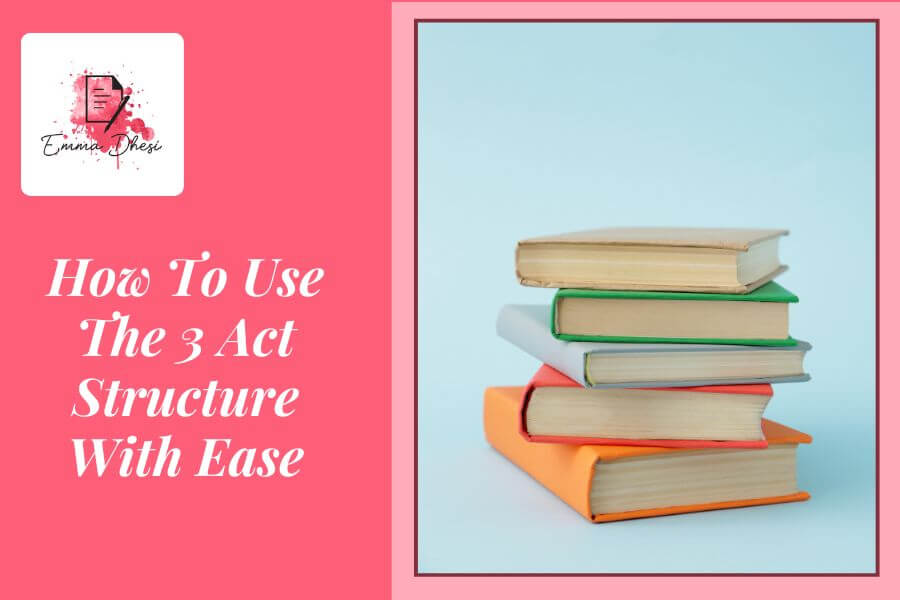3 Act Structure Guarantees A Fantastic Page Turner!
A bold statement, I know!
This blog post looks at the 3 Act Structure and in it I’m going to teach you what the 3 Act Structure is and why it’s the simplest way to guarantee you have a cause-and-effect plotline with conflict and action.
Alongside having memorable characters, you need an intriguing story arc. There’s a lot of debate about whether a character or a story is more important. But to me, they are the yin and the yang of any good book.
You need both if you’re going to write an excellent story.
What Is Structure?
Story structure is the framework used to ensure you hit all the right plot points and story beats.
There are many structures out there, including The Hero’s Journey, Save The Cat and, of course, the 3 Act Structure.
It’s the tool you use to take your character [link to how to deepen your fictional characters] out of their existing imperfect life and into the storyline.
Structure is the skeleton upon which you hang your story in the most logical, efficient and compelling way possible, so your reader doesn’t close your novel after the first chapter.
I believe, especially for new writers, the 3 Act Structure is the best structure to use because it gives you enough structure to get your character from A to Z but is loose enough that you can play around and experiment. It gives you room for ‘magic’.
‘Magic’ is what I call those epiphany moments when you suddenly realise how two seemingly disparate ideas you had are actually connected and where they fit in the story. Or, a character speaks to you and tells you what to write next, making your life so much easier!
Let’s break the 3 Act Structure down.

Inciting Incident
At the start of your story, we see your protagonist in their normal day-to-day life. Depending on the type of story you’re telling, that life could be near perfect, or it could be a complete shambles!
Either way, you need to convey your character’s normal life within the first couple of scenes.
Side Note: A chapter comprises either one scene or multiple scenes. This will depend on you and your style of writing. There is no one size fits all. Have a look at other books in the genre in which you’re writing and go with the one that feels most natural to you.
Within those first few scenes, we see their day-to-day life, but very quickly something comes in to disrupt that normal day. That’s why you choose to start your story there; it’s as close as possible to the moment when your protagonist’s life is turned upside down.
That moment is the Inciting Incident. It’s what kick starts the plotline. Your protagonist has officially started the story.
This is where a lot of new writers fall down. Although a major disruption has occurred in their protagonist’s life, the writer backs off from giving them anything to do. Instead, the character might have a cup of tea and think about what to do. But not do it.
You must give your protagonists something to do at this point. They need to take action. It’s this action point that then propels them out of the first act and into the second.
Remember, the action they take doesn’t need to be the right thing to do. It might be entirely the wrong thing to do, but that’s okay. The important thing here is that they take action.
Let’s think about Anna in The Woman In The Window by AJ Finn. The Inciting Incident here is that she thinks she witnesses the murder of Jane Russell.
What does she do? She phones the police, thus opening up a can of worms and the plotline begins!
Obstacles
From that moment on, your character comes face to face with a series of obstacles, each one more taxing difficult to overcome than the last.
This is what forms the Rising Action. Things get worse and worse until your protagonist is forced to face the very belief they are trying to hold on to but which isn’t serving them, i.e., their flaw.
I recommend you have at least three obstacles getting in your protagonist’s way. To ensure the cause-and-effect trajectory, keep in mind that the solution to first obstacle creates the second, and the solution to the second obstacle creates the third.
If we look again at The Woman In The Window, we see that when agoraphobic, and prescription-drug-addicted Anna phones the police, she has to let them into her house, something she desperately wants to avoid.
The police come and as she tries to explain what she thinks she saw; the police consider her flaky and unreliable as a witness. This is a problem for her if she’s going to persuade anyone that she witnessed Jane Russell’s murder.
Because nobody believes her, she has to prove she knew Jane Russell and did indeed see her bludgeoned to death. She’s proactive. She looks for witnesses who also knew Jane and may have seen them together, and clues that Jane came into her house.
What I want you to notice here is that one thing leads to another. You can do this in your stories. If your character’s husband says he’s leaving, what would she do to either make him stay or speed up the separation?
If your character is accused of a crime they didn’t commit, would they sit quietly and let the police build a case against them, or would they a) go on the run, or b) hire the best lawyer they could and prove their innocence?
If your character’s planet is being attacked, would they cry and wait for the invasion, or would they rally the troops and bring their best fight?
The trick is to make sure your character does something physical. You do not want them to head straight to a coffee shop to think on their own. If they go to a coffee shop, they are meeting someone to have a conversation about their situation and decide about what to do next.
This is how you create a cause-and-effect storyline whereby your character keeps making poor decisions that get them in hotter and hotter water!

The Climax
Eventually, your character reaches the climax of the story, and this is when they face their biggest obstacle or hurdle. This is the one that forces your character to change in a fundamental way, or do something they never thought possible.
It’s the moment they accept that the way they’re living life isn’t all that great and that, in fact, if they want a better life, they need to shake things up.
Therefore, getting to grips with your character’s flaws before you write is so important. Only when you know what your protagonist’s flaw is can you have them reflect on why things were so bad in the beginning, notice the changes they’ve made over the storyline, and identify how they will do things differently from now on.
For Anna in The Woman In The Window, it was only as someone was attempting to murder her that she recognised her drug addiction and agoraphobia were not keeping her safe, but were in fact holding her back from living a real life, outside, with other people, which is what she secretly wanted.
As undramatic as it sounds, your climax and ending need to be ‘satisfactory’. What this means is that you tie up any loose ends and leave your reader feeling all is right with the world for now. We know real life is more complicated than that, but for the purposes of fiction, most readers want to feel safe when they close the book for the last time.
They can take a breath to reset before they delve into your next novel!
Final Thoughts: A Word From An Expert
A final rule of thumb when it comes to building your story’s tension, remember what Hitchcock taught us:
“Drama is real life with the dull bits cut out.”
This is what drama is at its heart. Your reader doesn’t want to know the minutiae of your character’s day to day routine. They don’t need to know what your character had for breakfast, or what shower gel they use, or how they travel from A to B.
Focus on the drama and you’ll write a compelling, page turner or a novel!
If you liked this post, you might like this…
If you write a novel with any kind of relationship between two or more people, there may well be an intimate moment or two in your story. USA Today bestselling author Danika Bloom guided me through how to write intimate scenes (and we’re not talking just bedroom scenes, but any scene where there is intimacy – between partners, friends, parents and children. These are delicate moments and Danika gives you 8 tips to write passionate prose!
You can also catch our YouTube conversation here.


“leave your reader feeling all is right with the world for now.”
Gosh, darn it! There goes my “Great American Novel”! I want to show the reader all is NOT right with the world!
lol! Even if things are not right with the world at the moment, consider leaving them with the hope things could be in the future!